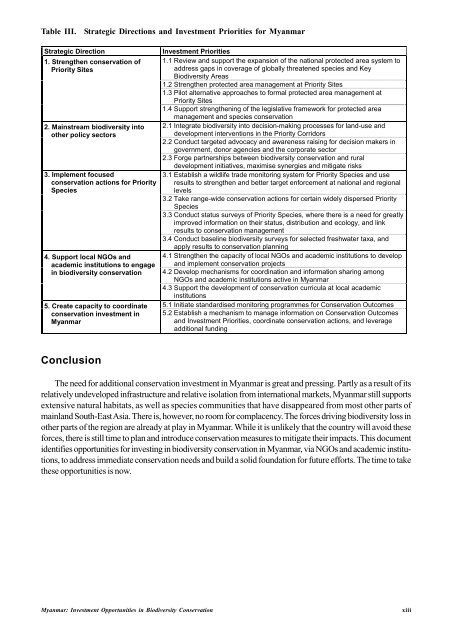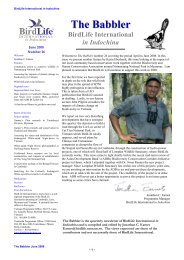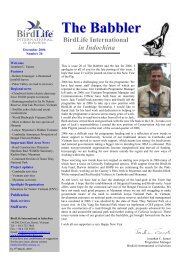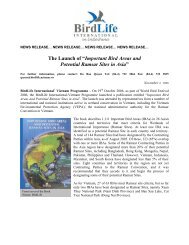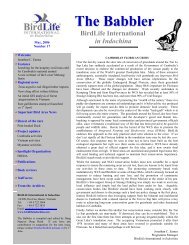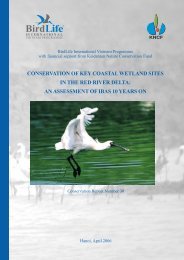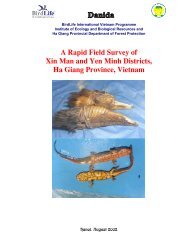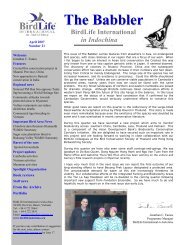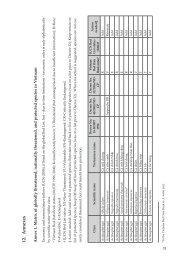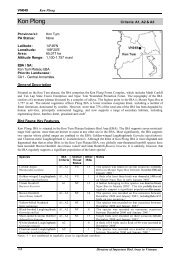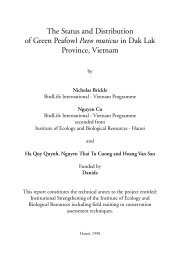Myanmar: Investment Opportunities in Biodiversity Conservation
Myanmar: Investment Opportunities in Biodiversity Conservation
Myanmar: Investment Opportunities in Biodiversity Conservation
You also want an ePaper? Increase the reach of your titles
YUMPU automatically turns print PDFs into web optimized ePapers that Google loves.
Table III. Strategic Directions and <strong>Investment</strong> Priorities for <strong>Myanmar</strong><br />
Strategic Direction <strong>Investment</strong> Priorities<br />
1. Strengthen conservation of 1.1 Review and support the expansion of the national protected area system to<br />
Priority Sites<br />
address gaps <strong>in</strong> coverage of globally threatened species and Key<br />
<strong>Biodiversity</strong> Areas<br />
1.2 Strengthen protected area management at Priority Sites<br />
1.3 Pilot alternative approaches to formal protected area management at<br />
Priority Sites<br />
1.4 Support strengthen<strong>in</strong>g of the legislative framework for protected area<br />
management and species conservation<br />
2. Ma<strong>in</strong>stream biodiversity <strong>in</strong>to 2.1 Integrate biodiversity <strong>in</strong>to decision-mak<strong>in</strong>g processes for land-use and<br />
other policy sectors<br />
development <strong>in</strong>terventions <strong>in</strong> the Priority Corridors<br />
2.2 Conduct targeted advocacy and awareness rais<strong>in</strong>g for decision makers <strong>in</strong><br />
government, donor agencies and the corporate sector<br />
2.3 Forge partnerships between biodiversity conservation and rural<br />
development <strong>in</strong>itiatives, maximise synergies and mitigate risks<br />
3. Implement focused<br />
3.1 Establish a wildlife trade monitor<strong>in</strong>g system for Priority Species and use<br />
conservation actions for Priority results to strengthen and better target enforcement at national and regional<br />
Species<br />
levels<br />
3.2 Take range-wide conservation actions for certa<strong>in</strong> widely dispersed Priority<br />
Species<br />
3.3 Conduct status surveys of Priority Species, where there is a need for greatly<br />
improved <strong>in</strong>formation on their status, distribution and ecology, and l<strong>in</strong>k<br />
results to conservation management<br />
3.4 Conduct basel<strong>in</strong>e biodiversity surveys for selected freshwater taxa, and<br />
apply results to conservation plann<strong>in</strong>g<br />
4. Support local NGOs and 4.1 Strengthen the capacity of local NGOs and academic <strong>in</strong>stitutions to develop<br />
academic <strong>in</strong>stitutions to engage and implement conservation projects<br />
<strong>in</strong> biodiversity conservation 4.2 Develop mechanisms for coord<strong>in</strong>ation and <strong>in</strong>formation shar<strong>in</strong>g among<br />
NGOs and academic <strong>in</strong>stitutions active <strong>in</strong> <strong>Myanmar</strong><br />
4.3 Support the development of conservation curricula at local academic<br />
<strong>in</strong>stitutions<br />
5. Create capacity to coord<strong>in</strong>ate 5.1 Initiate standardised monitor<strong>in</strong>g programmes for <strong>Conservation</strong> Outcomes<br />
conservation <strong>in</strong>vestment <strong>in</strong> 5.2 Establish a mechanism to manage <strong>in</strong>formation on <strong>Conservation</strong> Outcomes<br />
<strong>Myanmar</strong><br />
and <strong>Investment</strong> Priorities, coord<strong>in</strong>ate conservation actions, and leverage<br />
additional fund<strong>in</strong>g<br />
Conclusion<br />
The need for additional conservation <strong>in</strong>vestment <strong>in</strong> <strong>Myanmar</strong> is great and press<strong>in</strong>g. Partly as a result of its<br />
relatively undeveloped <strong>in</strong>frastructure and relative isolation from <strong>in</strong>ternational markets, <strong>Myanmar</strong> still supports<br />
extensive natural habitats, as well as species communities that have disappeared from most other parts of<br />
ma<strong>in</strong>land South-East Asia. There is, however, no room for complacency. The forces driv<strong>in</strong>g biodiversity loss <strong>in</strong><br />
other parts of the region are already at play <strong>in</strong> <strong>Myanmar</strong>. While it is unlikely that the country will avoid these<br />
forces, there is still time to plan and <strong>in</strong>troduce conservation measures to mitigate their impacts. This document<br />
identifies opportunities for <strong>in</strong>vest<strong>in</strong>g <strong>in</strong> biodiversity conservation <strong>in</strong> <strong>Myanmar</strong>, via NGOs and academic <strong>in</strong>stitutions,<br />
to address immediate conservation needs and build a solid foundation for future efforts. The time to take<br />
these opportunities is now.<br />
<strong>Myanmar</strong>: <strong>Investment</strong> <strong>Opportunities</strong> <strong>in</strong> <strong>Biodiversity</strong> <strong>Conservation</strong><br />
xiii


